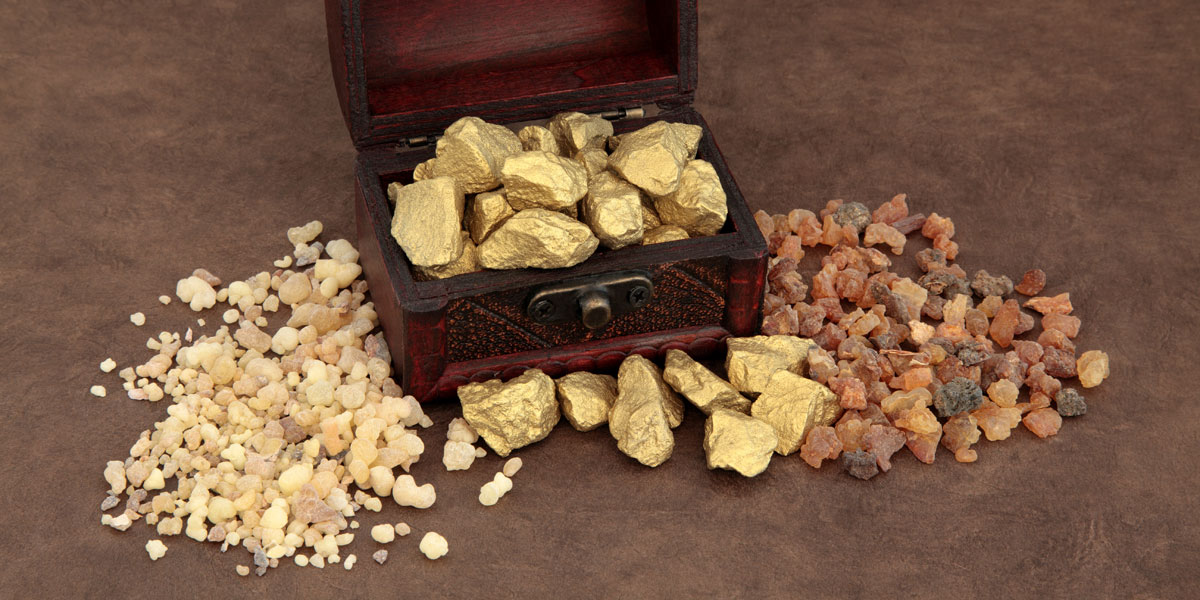You are here
Why Did the Wise Men Give Jesus Gold, Frankincense, and Myrrh?

2 Nephi 2:7
The Know
Shortly after Jesus was born, “wise men from the east” visited Him and gave Him gold, frankincense, and myrrh as gifts (Matthew 2:1). These gifts were all extremely valuable and expensive, and were the appropriate gifts for the “king of the Jews” as the wise men called Jesus (v.2). However, many people have shown that these gifts could be symbolic as well.1
Because crowns were traditionally made of gold, gold was thought to represent Christ’s kingship.2
Because of its use in religious ceremonies, frankincense was thought to represent Christ’s role as a priest.3 And because of its use in the embalming of Jesus, myrrh was thought to foreshadow Christ’s death.4 Although the Book of Mormon does not record these gifts that Christ received, it does refer to Christ’s roles as king and priest, as well as His death and resurrection.
Christ as King
The motif of Christ as King often appears in the Book of Mormon. However, many people do not recognize this because the Book of Mormon often uses words for “king” that modern readers associate with other things. The word Christ, for example, is Greek for “anointed one” and is often used to refer to kings, who were anointed when they received their coronation (see 2 Samuel 2:4).5
This word is the Greek equivalent of the Hebrew word Messiah, which also has the same connotations.6Therefore when we see “Christ” or “Messiah” in the Book of Mormon, one thing we should be thinking of is Christ’s role as Divine King.7
Christ as Priest
One occasion when the Book of Mormon mentions Christ’s role as priest is in 2 Nephi 2:7: “Behold, he offereth himself a sacrifice for sin, to answer the ends of the law, unto all those who have a broken heart and a contrite spirit; and unto none else can the ends of the law be answered.”8 The Old Testament refers to offering a sacrifice 49 times,9 and the Book of Mormon refers to it 5 times.10 In every case, offering a sacrifice refers to offering sacrifices according to the Law of Moses. Because these sacrifices were generally performed by priests, this verse is a reminder of Christ’s role as priest (see Hebrews 9:11).11
Christ’s Death and Resurrection
The power of Christ’s death and resurrection is the essence of the Book of Mormon, and it shows that Christ’s death is essential for all humanity: “Behold, they will crucify him; and after he is laid in a sepulchre for the space of three days he shall rise from the dead, with healing in his wings; and all those who shall believe on his name shall be saved in the kingdom of God” (2 Nephi 25:13).12 The Book of Mormon powerfully testifies that “the redemption of the people” is “brought to pass through the power, and sufferings, and death of Christ, and his resurrection and ascension into heaven” (Mosiah 18:2).
The Why
In a world where chaos sometimes holds sway, knowing that Christ is the king of the universe can bring comfort to our troubled lives.13 Christ rules over all that is, and will eventually triumph over evil, no matter how much evil we may sometimes experience.14 Because Christ is king, we can find peace.
Knowing that Christ is, as the author of Hebrews put it, “an high priest of good things to come,” (Hebrews 9:11) He can also help us as we go through life.15 The high priest of the Old Testament entered into the Holy of Holies once a year with the blood of an animal to atone for sins.16 But Christ, “by his own blood” has “entered in once into the holy place, having obtained eternal redemption for us” (Hebrews 9:12). Because Christ, the ultimate High Priest, has offered Himself for each of us, we can turn to Him to find redemption and to reconcile ourselves with God.17 Finally, because of Christ’s death and resurrection, we can all overcome death and pain. Christ's power allows all of us to be freed from the troubles of mortality, including physical death.18
Especially during the Christmas season, we can all remember the power of Christ’s Atonement and resurrection and the power He has to help us through our own lives. And when we think of the gold, frankincense and myrrh offered by the wise men, we can all remember Christ’s roles of king and priest and the power of his death and resurrection.19 These gifts, given by the wise men, remind us all of Christ’s gifts to us. These gifts can give us hope, reconciliation with God, and freedom from death.
Further Reading
“Scholars Focus Conference on Third Nephi,” Insights: The Newsletter of the Neal A. Maxwell Institute for Religious Scholarship 28, no. 6 (2008): 3–4.
Daniel K. Judd, “The Spirit of Christ: A Light Amidst the Darkness,” in Fourth Nephi Through Moroni, From Zion to Destruction, Book of Mormon Symposium Series, Volume 9, ed. Monte S. Nyman and Charles D. Tate, Jr. (Provo, UT: Religious Studies Center, Brigham Young University, 1995), 133–146.
Robert J. Matthews, “Two Ways in the World: The Warfare Between God and Satan,” in The Book of Mormon, Part 1: 1 Nephi to Alma 29, Studies in Scripture: Volume 7, ed. Kent P. Jackson (Salt Lake City, UT: Deseret Book, 1987), 146–161.
- 1. “Strata: The Magi’s Gifts—Tribute or Treatment?” Biblical Archaeology Review 38, no. 1 (2012): 24.
- 2. “The Magi’s Gifts,” 24.
- 3. “The Magi’s Gifts,” 24.
- 4. “The Magi’s Gifts,” 24. For more on Myrrh, see Roland K. Harrison, “Myrrh” in The International Standard Bible Encyclopedia, 4 vols., ed. Geoffrey W. Bromiley (Grand Rapids, MI: William B. Eerdmans Publishing Company, 1986), 3:450–451.
- 5. Theological Dictionary of the New Testament, ed. Gerhard Friedrich (Grand Rapids, MI: Eerdmans, 1971), 9:510.
- 6. See Book of Mormon Central, “Why Does an Angel Reveal the Name of Christ to Jacob? (2 Nephi 10:3),” KnoWhy 36 (February 18, 2016).
- 7. See Stephen D. Ricks, “Kingship, Coronation, and Covenant in Mosiah 1–6,” in King Benjamin’s Speech: “That Ye May Learn Wisdom”, ed. John W. Welch and Stephen D. Ricks (Provo, UT: FARMS, 1998), 265.
- 8. For more on Christ as the High Priest, see Matthew Grey’s presentation, “‘Jesus Blessed Them . . . and His Countenance Did Shine Upon Them’: Understanding Third Nephi 19 in Light of the Priestly Blessing,” given at the September 2008 conference, “Third Nephi: New Perspectives on an Incomparable Scripture,” held at Brigham Young University. The brief summary of the presentation can be found in “Scholars Focus Conference on Third Nephi,” Insights: The Newsletter of the Neal A. Maxwell Institute for Religious Scholarship 28, no. 6 (2008): 3–4.
- 9. The New Strong’s Expanded Exhaustive Concordance of the Bible (Nashville, TN: Thomas Nelson Publishers, 2001), 628–633.
- 10. Eldin Ricks’s Thorough Concordance of the LDS Standard Works (Provo, UT: FARMS, 1995), 546.
- 11. For another priestly function Christ performed in the Book of Mormon, see Book of Mormon Central, “Why Did Jesus Allude to the Priestly Blessing in Numbers 6? (3 Nephi 19:25),” KnoWhy 212 (October 19, 2016).
- 12. For more on this, see Book of Mormon Central, “Why Does Abinadi Use the Phrase ‘The Bands of Death’? (Mosiah 15:8),” KnoWhy 93 (May 5, 2016).
- 13. See Daniel K. Judd, “The Spirit of Christ: A Light Amidst the Darkness,” in Fourth Nephi Through Moroni, From Zion to Destruction, Book of Mormon Symposium Series, Volume 9, ed. Monte S. Nyman and Charles D. Tate, Jr. (Provo, UT: Religious Studies Center, Brigham Young University, 1995), 133–134.
- 14. For more on Christ’s conquest over evil, see Robert J. Matthews, “Two Ways in the World: The Warfare Between God and Satan,” in The Book of Mormon, Part 1: 1 Nephi to Alma 29, Studies in Scripture: Volume 7, ed. Kent P. Jackson (Salt Lake City, UT: Deseret Book, 1987), 146–161.
- 15. Hugh Nibley, An Approach to the Book of Mormon, The Collected Works of Hugh Nibley, Volume 6 (Salt Lake City and Provo, UT: Deseret Book and Neal A. Maxwell Institute for Religious Scholarship, 1988), 162–163.
- 16. See Brant A. Gardner, Second Witness: Analytical and Contextual Commentary on the Book of Mormon, 6 vols. (Salt Lake City, UT: Greg Kofford Books, 2007), 2:39.
- 17. See Joseph Fielding McConkie and Robert L. Millet, Doctrinal Commentary on the Book of Mormon, 4 vols. (Salt Lake City, UT: Bookcraft, 1987–1992), 1:192–193.
- 18. See Robert J. Matthews, “Jesus Christ” in Book of Mormon Reference Companion, ed. Dennis Largey (Salt Lake City, UT: Deseret Book, 2003), 452–453.
- 19. Gary P. Gillum, “Christology,” Encyclopedia of Mormonism, 4 vols., ed. Daniel H. Ludlow (New York, NY: Macmillan, 1992), 1:272–273.
KnoWhy Citation
Related KnoWhys
Subscribe
Get the latest updates on Book of Mormon topics and research for free





